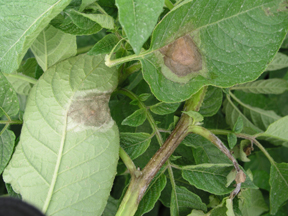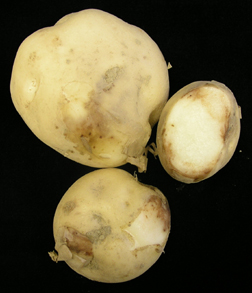Bulletin #2441, Potato Late Blight
Bulletin #2441, Potato Late Blight (PDF)
Extension Crops Specialist Steven B. Johnson
For information about UMaine Extension programs and resources, visit extension.umaine.edu.
Find more of our publications and books at extension.umaine.edu/publications/.
Late Blight History
Few plant diseases can rival the widespread misery and despair produced by potato late blight. Potato late blight is caused by Phytophthora infestans, a fungus-like organism that over-seasons in infected tubers, cull piles, and in infected volunteer plants. The disease was noted in the U.S. in 1842, in Canada in 1844, and in Belgium during 1845. Three weeks of cool, foggy, rainy conditions in Ireland during 1845 helped create the late blight famine of 1845 to 1847 in which potato crops were decimated by the disease. Between 1845 and 1860, one million people died in Ireland alone as a direct consequence of famine, and one and one half million emigrated from Ireland. The “hungry forties” in England and other parts of Europe were also a result of potato late blight.
Causal Organism
Phytophthora infestans is a specialized pathogen of potato and can cause infections in potato foliage and tubers. This organism has been historically treated as a fungus. P. infestans can also infect wild relatives of potatoes as well as tomatoes (Lycopersicon esculentum), petunias (Petunia hybrida), and a few other species of plants. All parts of the potato plant are susceptible to the pathogen.
The pathogen is an obligate parasite which cannot survive in the absence of a host; it cannot survive in soil or dead plant debris. This organism will not survive long in soil or away from association with a living host. For an epidemic to begin in any one area, the organism must survive the winter in that area (in potato tubers, as culls or volunteers), be introduced on seed potatoes or transplants to the area, or have viable spores blow into the area. The organism is dispersed via wind-borne sporangia. While these sporangia can be dispersed long distances, most of the distribution is over very short distances. As they are subject to desiccation, sporangia last only a few hours in dry, sunny conditions. Under conditions of free moisture, these sporangia can germinate within a few hours. Germination of sporangia is either direct by a germ tube or indirect, with about 8 flagellated zoospores produced and released. These zoospores can infect the plant tissue either through direct penetration of the epidermis or through the stomata. Once inside the potato tissue, the organism begins to kill the tissue, thus causing the distinct lesions.
Disease Cycle
In Maine, the organism causing potato late blight typically overwinters in infected tubers in cull piles, infected volunteer plants, or in seed. Infected tubers sprout, the organism develops, and under moist conditions, spore production is initiated. These spores are carried primarily by the wind to nearby fields. With the presence of free moisture, these spores germinate, infect the potato plant, and the cycle repeats. This organism can complete many reproductive cycles in a growing season.
Development of the lesions is favored by cool, moist weather. Nighttime temperatures in the 50s with daytime temperatures in the 70s, accompanied by rain, fog, or heavy dew, are ideal. Under Maine conditions, lesions appear on leaves in about 7 days after infection. Under ideal conditions, lesions have appeared in as little as 5 days after infection. It has been estimated that typical lesions produce up to 250,000 spores per day. This helps explain the rapid and devastating spread of the disease once it becomes established in a field.
Leaf lesions may become visible as small, lighter green areas as soon as five days after infection. These quickly enlarge as the pathogen grows through the leaf tissue. About 7 days after infection, the lesion will sporulate. White, fluffy reproductive spores are abundant on the edge of the lesion on the underside of the leaf. Older lesions will sporulate only when temperatures are between 60°F and 70°F with more than 10 hours of high relative humidity.
Tuber infection occurs when the spores from the foliage are washed into the soil. When these spores germinate indirectly through zoospores, there is a much higher probability of tuber infection than with direct spore germination. The zoospores are motile and more abundant than the sporangia and predominate at soil temperatures between 40°F and 55°F.
Tuber infection can occur anytime during the season that tubers are present. Realistically, most of the tuber infection occurs late in the growing season with rain events leading to saturated soil and cool soil temperatures. Sporangia can survive for days or even weeks in the soil but, most commonly, tuber infection occurs soon after sporangia movement into the soil. Tuber infections with soil temperatures greater than 65°F are not common. Tubers infected during the growing season may partially to completely decay before harvest.
Tuber infection can also occur at harvest when there is contact between tubers and spores. This typically occurs when tubers come into contact with infected green foliage. Skinning of the tubers during harvest greatly increases the risk of infection. Harvesting tubers with a coating of pathogen-contaminated soil also increases the risk of tuber infection. Tuber-to-tuber contact during loading and handling as the tubers are entering a storage area are also possible avenues for tuber infection. Under proper storage management, the tuber-to-tuber spread of late blight is minimal or absent.
Symptoms

Late blight lesions can occur on all plant parts. Potato late blight leaf lesions first appear as fast-growing, irregularly shaped, pale to dark green, water‑soaked spots. These usually appear at the tips of the leaves or on actively growing tissue. The lesions enlarge rapidly and form brown to purplish‑black areas of dead tissue with indefinite borders. A yellowish‑green halo will usually appear surrounding these lesions. In cool, wet weather, or other humid conditions, a ring or a surface of white fungal-like growth may appear at the edge of the lesion on the underside of the leaf. The lesions are often covered with a glistening white fungal-like growth. In cool, wet weather, late blight may move rapidly from leaves to petioles and stems and infect an entire field in only a few days. A field heavily infected with late blight will have a distinct fetid odor. The odor is that of rapidly dying potato foliage and is similar to that of vine killing. In dry weather, the water‑soaked halo disappears from the lesions and the dead tissue becomes brown and dry.
Late blight spores will also infect tubers, frequently at harvest time, but can attack tubers any time in the field or while in storage. At first, the infected tubers have a brown to purple sunken discoloration of the skin. The margin between diseased and healthy tissue is not distinct. Brown, sometimes granular, peg‑like projections may penetrate into healthy tissue to various depths. In newly harvested tubers, white tufts of fungal-like growth may appear at the lenticels, eyes, or on surface damage. Under cool, dry storage conditions, tuber lesions develop slowly as typical dry rots. Often, secondary organisms invade the diseased tubers and can result in a complete breakdown of the tuber.
Late Blight Control

Late blight is a community issue and those in the growing community need to be part of the solution. To control potato late blight, growers need to take a multi-pronged approach. Cultural control alone or chemical control alone will not provide adequate protection during the late blight epidemics. Growers should plant certified seed free of late blight, and eliminate cull piles and volunteer potatoes. The addition of a seed treatment effective in reducing late blight should be considered.
Controlling solanaceous weeds, particularly those in the nightshade family, is important for reducing the late blight in the area. Scouting locations where late blight is likely to occur or has occurred in the past is a good method for early detection of the disease.
Hot, dry weather is very effective in slowing late blight development, as are proper applications of fungicides. Fungicides should be applied based on a forecasting scheme. Typically forecasting schemes predict the initiation of sprays and the frequency of subsequent applications. However, once late blight reaches a high proportion in the field, fungicides will not control the pathogen and the field will likely reach 100 percent infection. Under some conditions, early vine killing to parts or an entire field is recommended as a control measure for late blight.
Vine killing is an important step for late blight control. Fields with late blight should be thoroughly dead before harvest. A minimum of two weeks — preferably three weeks — after vine kill should occur before harvest. This allows the skin to set and lowers the numbers of viable spores in the soil. Minimizing bruising and skinning during harvest will minimize the tuber-to-tuber transmission of the pathogen.
Reviewed by Extension Crops Specialist James Dwyer
Information in this publication is provided purely for educational purposes. No responsibility is assumed for any problems associated with the use of products or services mentioned. No endorsement of products or companies is intended, nor is criticism of unnamed products or companies implied.
© 2010, 2020
Call 800.287.0274 (in Maine), or 207.581.3188, for information on publications and program offerings from University of Maine Cooperative Extension, or visit extension.umaine.edu.
In complying with the letter and spirit of applicable laws and pursuing its own goals of diversity, the University of Maine System does not discriminate on the grounds of race, color, religion, sex, sexual orientation, transgender status, gender, gender identity or expression, ethnicity, national origin, citizenship status, familial status, ancestry, age, disability physical or mental, genetic information, or veterans or military status in employment, education, and all other programs and activities. The University provides reasonable accommodations to qualified individuals with disabilities upon request. The following person has been designated to handle inquiries regarding non-discrimination policies: Director of Institutional Equity and Title IX Services, 5713 Chadbourne Hall, Room 412, University of Maine, Orono, ME 04469-5713, 207.581.1226, TTY 711 (Maine Relay System).

